2010 HONDA FIT airbag
[x] Cancel search: airbagPage 28 of 351
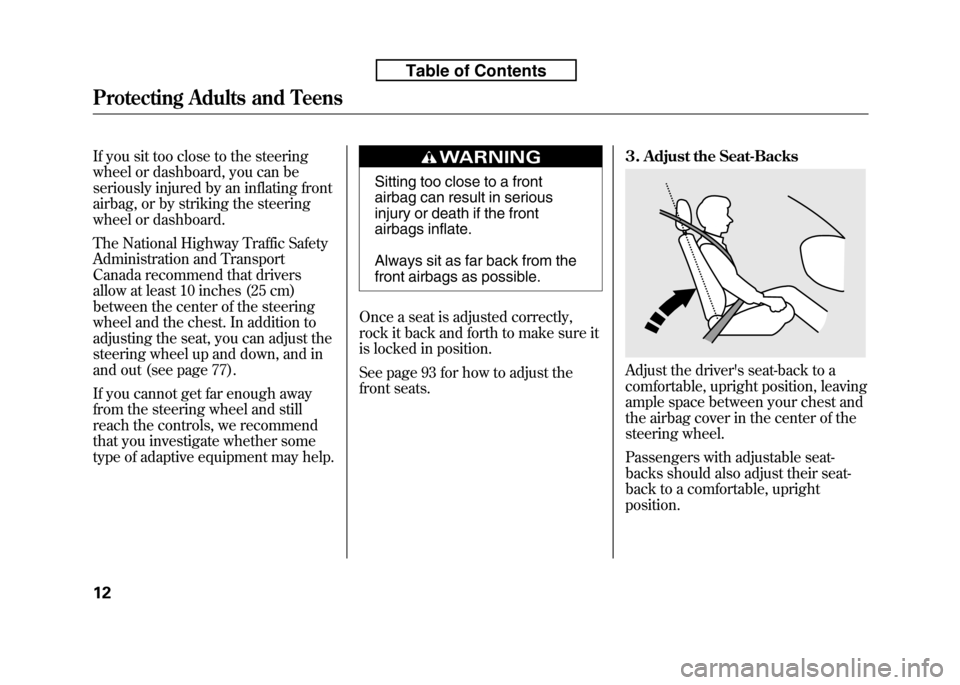
If you sit too close to the steering
wheel or dashboard, you can be
seriously injured by an inflating front
airbag, or by striking the steering
wheel or dashboard.
The National Highway Traffic Safety
Administration and Transport
Canada recommend that drivers
allow at least 10 inches (25 cm)
between the center of the steering
wheel and the chest. In addition to
adjusting the seat, you can adjust the
steering wheel up and down, and in
and out (see page 77).
If you cannot get far enough away
from the steering wheel and still
reach the controls, we recommend
that you investigate whether some
type of adaptive equipment may help.
Sitting too close to a front
airbag can result in serious
injury or death if the front
airbags inflate.
Always sit as far back from the
front airbags as possible.
Once a seat is adjusted correctly,
rock it back and forth to make sure it
is locked in position.
See page 93 for how to adjust the
front seats. 3. Adjust the Seat-Backs
Adjust the driver's seat-back to a
comfortable, upright position, leaving
ample space between your chest and
the airbag cover in the center of the
steering wheel.
Passengers with adjustable seat-
backs should also adjust their seat-
back to a comfortable, uprightposition.
Protecting Adults and Teens
12
Table of Contents
Page 32 of 351
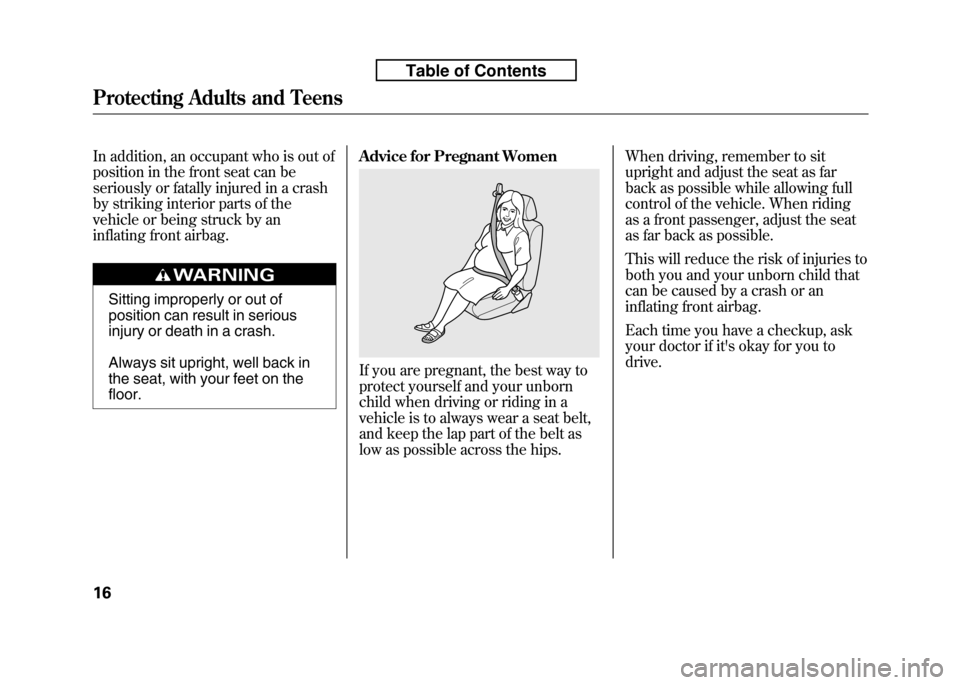
In addition, an occupant who is out of
position in the front seat can be
seriously or fatally injured in a crash
by striking interior parts of the
vehicle or being struck by an
inflating front airbag.
Sitting improperly or out of
position can result in serious
injury or death in a crash.
Always sit upright, well back in
the seat, with your feet on thefloor.Advice for Pregnant Women
If you are pregnant, the best way to
protect yourself and your unborn
child when driving or riding in a
vehicle is to always wear a seat belt,
and keep the lap part of the belt as
low as possible across the hips. When driving, remember to sit
upright and adjust the seat as far
back as possible while allowing full
control of the vehicle. When riding
as a front passenger, adjust the seat
as far back as possible.
This will reduce the risk of injuries to
both you and your unborn child that
can be caused by a crash or an
inflating front airbag.
Each time you have a checkup, ask
your doctor if it's okay for you todrive.
Protecting Adults and Teens
16
Table of Contents
Page 33 of 351

Additional Safety Precautions●
Never let passengers ride in the
cargo area or on top of a folded-
down back seat.
If they do, they
could be very seriously injured in a crash.
●
Never let passengers ride in the area in front of a folded-up rearseat or on top of a folded-down rear
seat.
If they do, they could be very
seriously injured in a crash.
●
Passengers should not stand up or change seats while the vehicle is
moving.
A passenger who is not
wearing a seat belt during a crash
or emergency stop can be thrown
against the inside of the vehicle,
against other occupants, or out of
the vehicle.
●
Two people should never use the same seat belt.
If they do, they
could be very seriously injured in acrash. ●
Do not put any accessories on seat
belts.
Devices intended to improve
occupant comfort or reposition the
shoulder part of a seat belt can
reduce the protective capability of
the belt and increase the chance of
serious injury in a crash.
●
Do not place hard or sharp objects between yourself and a front
airbag.
Carrying hard or sharp
objects on your lap, or driving with
a pipe or other sharp object in your
mouth, can result in injuries if your
front airbag inflates.
●
Keep your hands and arms away from the airbag covers.
If your
hands or arms are close to an
airbag cover, they could be injured
if the airbag inflates. ●
Do not attach or place objects on
the front airbag covers.
Objects on
the covers marked ‘‘SRS AIRBAG ’’
could interfere with the proper
operation of the airbags or be
propelled inside the vehicle and
hurt someone if the airbags inflate.
●
Do not attach hard objects on or near a door.
If a side airbag or a
side curtain airbag inflates, a cup
holder or other hard object
attached on or near the door could
be propelled inside the vehicle and
hurt someone.
●
Do not cover or replace front seat- back covers without consulting
your dealer.
Improperly replacing
or covering front seat-back covers
can prevent your side airbags from
inflating during a side impact.
Protecting Adults and Teens
17
Driver and Passenger Safety
Table of Contents
Page 34 of 351

Seat Belt System Components
Your seat belt system includes lap/
shoulder belts in all seating positions.
The front seat belts are also equipped
with automatic seat belt tensioners.
This system uses the same sensors as
the front airbags to monitor whether
the front seat belts are latched or
unlatched, and how much weight is on
the front passenger's seat (see page27).
The seat belt system includes
an indicator on the instrument
panel and a beeper to remind you and
your passengers to fasten your seatbelts.
This system monitors the front seat
belts. If you turn the ignition switch to
the ON (II) position before your seat
belt is fastened, the beeper will sound
and the indicator will flash. If your seat
belt is not fastened before the beeper
stops, the indicator will stop flashing
but remain on. If a front passenger does not fasten
their seat belt, the indicator will
come on about 6 seconds after the
ignition switch is turned to the ON
(II) position.
If either the driver or a front
passenger does not fasten their seat
belt while driving, the beeper will
sound and the indicator will flash
again at regular intervals.
When no one is sitting in the front
passenger's seat, or a child or small
adult is riding there, the indicator
should not come on and the beeper
should not sound.
If the indicator comes on or the
beeper sounds when the driver's seat
belt is latched and there is no front
seat passenger and no items on the
front seat, something may be
interfering with the monitoring
system. Look for and remove:
● Any items under the front
passenger's seat.
● Any object(s) hanging on the seat
or in the seat-back pocket.
● Any object(s) touching the rear of
the seat-back.
If no obstructions are found, have
your vehicle checked by a dealer.
Additional Information About Your Seat Belts
18
Table of Contents
Page 36 of 351
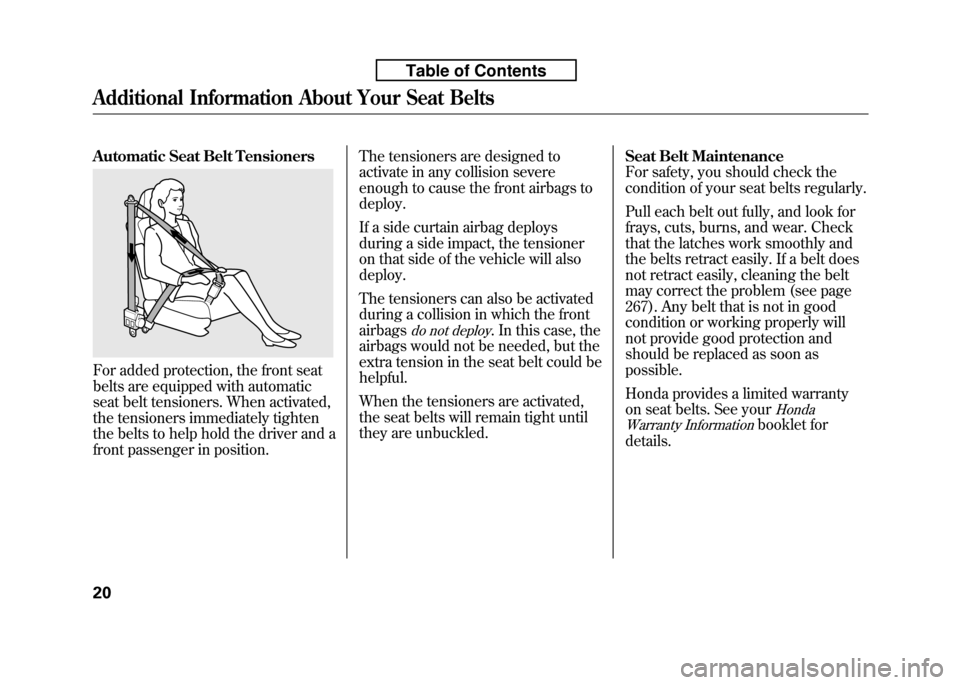
Automatic Seat Belt Tensioners
For added protection, the front seat
belts are equipped with automatic
seat belt tensioners. When activated,
the tensioners immediately tighten
the belts to help hold the driver and a
front passenger in position.The tensioners are designed to
activate in any collision severe
enough to cause the front airbags todeploy.
If a side curtain airbag deploys
during a side impact, the tensioner
on that side of the vehicle will alsodeploy.
The tensioners can also be activated
during a collision in which the frontairbags
do not deploy. In this case, the
airbags would not be needed, but the
extra tension in the seat belt could behelpful.
When the tensioners are activated,
the seat belts will remain tight until
they are unbuckled. Seat Belt Maintenance
For safety, you should check the
condition of your seat belts regularly.
Pull each belt out fully, and look for
frays, cuts, burns, and wear. Check
that the latches work smoothly and
the belts retract easily. If a belt does
not retract easily, cleaning the belt
may correct the problem (see page
267). Any belt that is not in good
condition or working properly will
not provide good protection and
should be replaced as soon aspossible.
Honda provides a limited warranty
on seat belts. See your
Honda
Warranty Information
booklet for
details.
Additional Information About Your Seat Belts
20
Table of Contents
Page 38 of 351
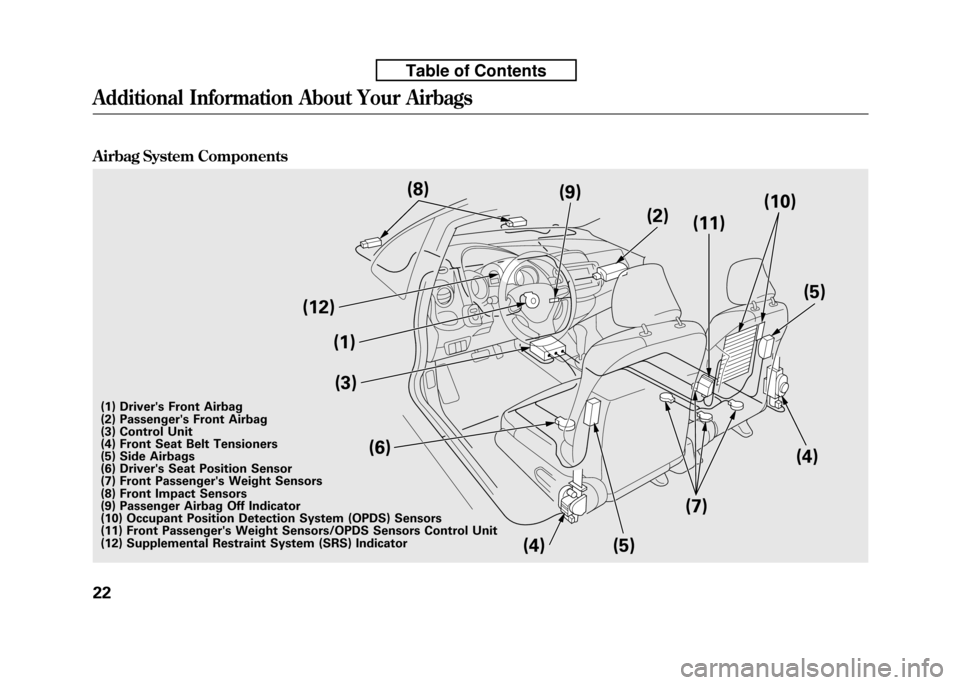
Airbag System Components
(1)(3)
(6)
(12)
(4) (5)(11)
(4)
(7) (5)
(9)
(10)
(2)
(8)
(1) Driver's Front Airbag
(2) Passenger's Front Airbag
(3) Control Unit
(4) Front Seat Belt Tensioners
(5) Side Airbags
(6) Driver's Seat Position Sensor
(7) Front Passenger's Weight Sensors
(8) Front Impact Sensors
(9) Passenger Airbag Off Indicator
(10) Occupant Position Detection System (OPDS) Sensors
(11) Front Passenger's Weight Sensors/OPDS Sensors Control Unit
(12) Supplemental Restraint System (SRS) Indicator
Additional Information About Your Airbags
22
Table of Contents
Page 39 of 351
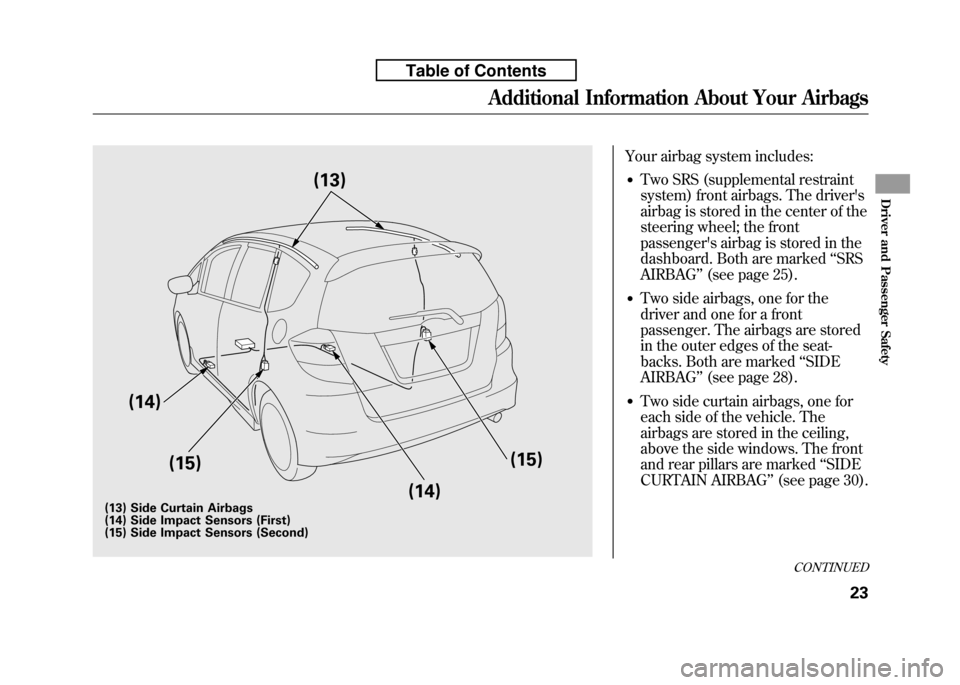
Your airbag system includes:● Two SRS (supplemental restraint
system) front airbags. The driver's
airbag is stored in the center of the
steering wheel; the front
passenger's airbag is stored in the
dashboard. Both are marked ‘‘SRS
AIRBAG ’’(see page 25).
● Two side airbags, one for the
driver and one for a front
passenger. The airbags are stored
in the outer edges of the seat-
backs. Both are marked ‘‘SIDE
AIRBAG ’’(see page 28).
● Two side curtain airbags, one for
each side of the vehicle. The
airbags are stored in the ceiling,
above the side windows. The front
and rear pillars are marked ‘‘SIDE
CURTAIN AIRBAG ’’(see page 30).
(14)
(15) (14)(15)
(13)
(13) Side Curtain Airbags
(14) Side Impact Sensors (First)
(15) Side Impact Sensors (Second)
CONTINUED
Additional Information About Your Airbags
23
Driver and Passenger Safety
Table of Contents
Page 40 of 351

●Automatic front seat belt
tensioners (see page 20).
● Sensors that can detect a moderate
to severe front impact or sideimpact.
● Sensors that can detect whether a
child is in the passenger's side
airbag path and signal the control
unit to turn the airbag off (see
page 29).
● Sensors that can detect whether
the driver's seat belt and the front
passenger's seat belt are latched or
unlatched (see page 18).
● A driver's seat position sensor that
monitors the distance of the seat
from the front airbag. If the seat is
too far forward, the airbag will
inflate with less force (see page27). ●
Weight sensors that monitor the
weight on the front passenger's
seat. If the weight is about 65 lbs
(29 kg) or less (the weight of an
infant or small child), the
passenger's front airbag will be
turned off (see page 27).
● A sophisticated electronic system
that continually monitors and
records information about the
sensors, the control unit, the
airbag activators, the seat belt
tensioners, and driver and front
passenger seat belt use when the
ignition switch is in the ON (II)position.
● An indicator on the instrument
panel that alerts you to a possible
problem with your airbags,
sensors, or seat belt tensioners
(see page 30). ●
An indicator on the instrument
panel that alerts you that the
passenger's side airbag has been
turned off (see page 31).
● An indicator on the dashboard that
alerts you that the passenger's
front airbag has been turned off
(see page 31).
● Emergency backup power in case
your vehicle's electrical system is
disconnected in a crash.
Additional Information About Your Airbags
24
Table of Contents